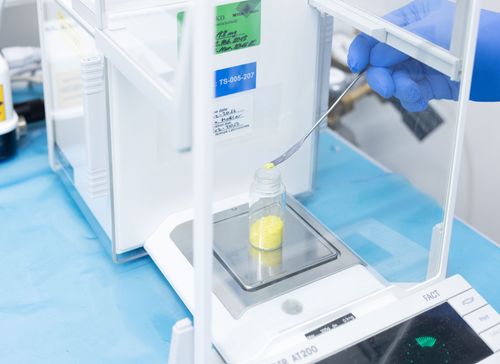
Custom synthesis direct catalytic H/T exchange
Direct catalytic H/T exchange on organic molecules is becoming increasingly popular, as no additional precursor synthesis is required and the exchange takes place directly on the target molecule. A variety of homogeneous and heterogeneous catalysts are available for this purpose. The choice of catalyst and the reaction conditions control the selectivity of tritium incorporation.
Iridium(I) catalysts
Various homogeneous iridium(I) catalysts are available for the direct labelling of molecules with tritium. Depending on the type of catalyst, different directing substrate groups are used for the incorporation of tritium. Prominent examples of such catalysts are the ones developed by Robert Crabtree and William Kerr, which incorporate tritium on aromatic systems in ortho positions to the directing groups.
EMPA
Brodiafacoum
Tolcapone
Rhodium Black
Rhodium black is a finely dispersed, metallic rhodium with a large catalytically active surface. Rhodium black is able to replace hydrogen in the immediate vicinity of nitrogen atoms and pyridine nitrogen atoms with tritium. Compared to iridium(I) catalysts, this is a heterogeneous catalysis. The catalyst can be separated by filtration after the reaction.
Nicotine
Nicotineamide
Metallic nanoparticles
Metallic nanoparticles as novel catalysts for hydrogen isotope exchange are the subject of current research at our company. In several scientific studies, we were able to show that metallic nanoparticles are characterised by a higher degree of labelling than conventional and commercially available heterogeneous catalysts. They are also characterised by their exceptional selectivity when incorporating tritium into complex biological and pharmaceutical molecules. In our laboratory we use ruthenium, rhodium, palladium and iridium nanoparticles. The different metals complement each other in their selectivity for tritium incorporation and, thus, often lead to high specific activities in the labelled product.
Dopamine
Serotonin
Epibatidine
UCB-J
Photocatalysis
Hydrogen atoms in the alpha position can be replaced by photocatalysis of tertiary amines. Very high specific activities can be achieved with this method. However, certain functional groups can lead to side reactions.
Clomipramine
Ketanserin
High Temperature Solid State Catalyzed Isotope Exchange (HSCIE)
Substrates can be adsorbed as solids on a suitable catalyst and then exposed to a tritium atmosphere at high temperatures (>200 °C). However, it is difficult to predict which specific activities will be achieved. The method is only suitable for thermally stable molecules with a high melting and decomposition point. The advantage is that chirality centres are generally retained during the reaction.
MK-801
Glycine